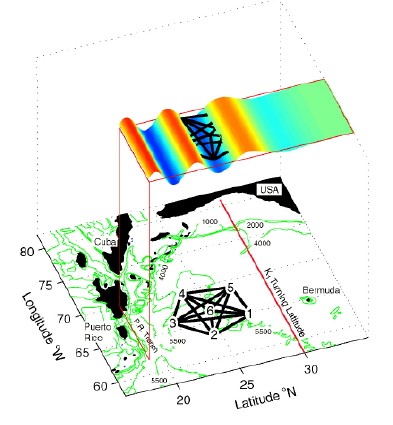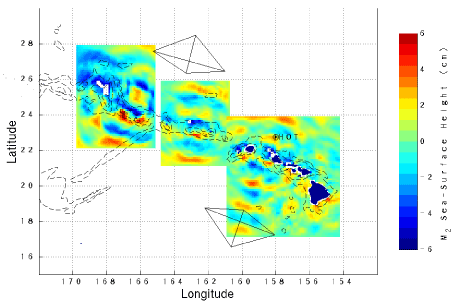Barotropic and Baroclinic TidesMeasurements of Barotropic Tidal Currents.Work on the barotropic tides with tomography data began as a convenient way to test and calibrate the acoustic measurements of ocean currents. Currents are measured acoustically using the difference of reciprocal travel times. Soon, however, the situation was reversed. That is, the tomography measurements are now being used to test and calibrate the global tidal models. Tomography offers perhaps the only way to accurately measure tidal currents; tomography is inherently a large-scale, depth-averaging measurement. Historical or available current meter measurements do not provide sufficient accuracy to critically test tidal models. Such critical tests are useful because of the wide range of applications of the global tidal models, e.g., estimates of barotropic tidal dissipation at topographic features, or measurements of the effect of tidal currents on the rotation rate of the earth. Dushaw, B. D., G. D. Egbert, P. F. Worcester, B. D. Cornuelle, B. M. Howe, and K. Metzger, 1997. A TOPEX/POSEIDON global tidal model (TPXO.2) and barotropic tidal currents determined from long-range acoustic transmissions. Prog. Oceanogr., 40, 337-367. Dushaw, B. D., P. F. Worcester, B. D. Cornuelle, B. M. Howe, and D. S. Luther, 1995. Baroclinic and barotropic tides in the central North-Pacific Ocean determined from long-range reciprocal acoustic transmissions. J. Phys. Oceanogr., 25, 631-647. Resonant Diurnal Internal Tides of the Western North Atlantic.
Click on the figure to see a gif animation of the wave! The animation also shows the barotropic tide elevation and the tidal current near Puerto Rico. Dushaw, B. D., A review of internal tide observations by acoustic tomography and altimetry, Proc. 5th Pacific Ocean Remote Sensing Conf. (PORSEC), Goa, India, 5-8 December 2000, vol. II, 651-652. Download pdf file (25KB) Dushaw, B. D., and P. F. Worcester, 1998. Resonant diurnal internal tides in the North Atlantic, Geophys. Res. Lett., 25, 2189-2193. Download pdf file (20 MB) Dushaw, B. D., G. D. Egbert, P. F. Worcester, B. D. Cornuelle, B. M. Howe, and K. Metzger, 1997. A TOPEX/POSEIDON global tidal model (TPXO.2) and barotropic tidal currents determined from long-range acoustic transmissions. Prog. Oceanogr., 40, 337-367. Dushaw, B. D., P. F. Worcester, B. D. Cornuelle, B. M. Howe, and D. S. Luther, 1995. Baroclinic and barotropic tides in the central North-Pacific Ocean determined from long-range reciprocal acoustic transmissions. J. Phys. Oceanogr., 25, 631-647. The Farfield Component of the Hawaiian Ocean Mixing Experiment (H.O.M.E.)(Funded by the National Science Foundation)
One goal is to make accurate measurements of the barotropic tidal currents so that the divergence of barotropic energy flux (i.e., the tidal energy lost at the Ridge) can be accurately calculated. Another goal is to accurately measure the energy that is radiated from the Ridge by low-mode baroclinic tides. This radiated energy is a sink of energy for the barotropic tide. The colors in the figure show the fluctuations in sea-surface height at the M2 frequency derived from the results of a primitive equations ocean model forced by a barotropic tidal model (see the link to H.O.M.E. above for more information on Holloway and Merrifield's ocean model results). The sea-surface height is mainly determined by the lowest internal-wave mode, and tomography is most sensitive to this mode. The effectiveness of the Hawaiian Ridge topography at generating internal tides is nonuniform along the Ridge, so that the radiating waves have concentrations of greater and lesser energy. Click on the figure to see a gif animation of the waves! (A 500 KB file) Dushaw, B. D., 2002. Mapping low-mode internal tides near Hawaii using TOPEX/POSEIDON altimeter data, Geophys. Res. Lett., 29(9), 10.1029/2001GL013944. Download pdf file (2 MB) APL Link: HOME Deep Sea Moorings
|

